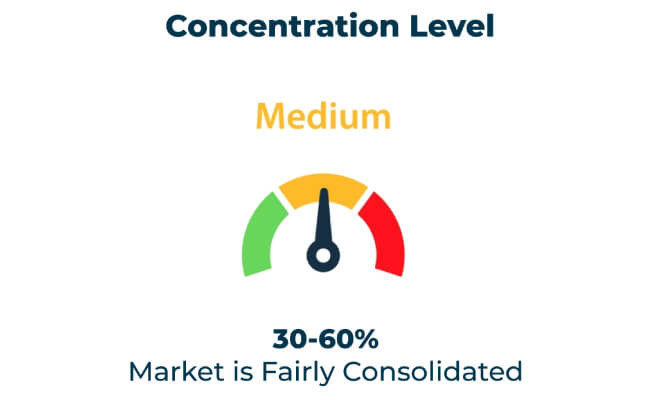The fluorinated bottle market is witnessing steady growth, driven by increasing demand for high-performance, durable, and chemical-resistant packaging solutions across industries such as chemicals, pharmaceuticals, and agrochemicals.
Key growth drivers include advancements in fluorination technology, stringent safety regulations, and the rising need for safe storage and transport of hazardous materials.
Manufacturers are focusing on innovative fluorination processes, customizable designs, and lightweight solutions to meet the dynamic needs of various industries. Partnerships with chemical manufacturers, pharmaceutical companies, and logistics providers are further accelerating the adoption of fluorinated bottles globally.
Exclusive Offer: 30% Off on Regional Reports
Get a free sample report and customize your regions for a 30% discount on your regional report!
Summary
This analysis outlines the positioning of major players in the fluorinated bottle market. Plastipak Holdings leads with innovative fluorinated bottle solutions but faces challenges with fluctuating raw material costs. Alpha Packaging excels in durable and customizable designs but struggles with scalability in emerging markets. Graham Packaging Company focuses on eco-friendly and lightweight solutions but encounters competition from alternative materials. Opportunities lie in leveraging sustainability trends and expanding applications for fluorinated bottles, while threats include regulatory changes and increasing competition.
Plastipak Holdings
Plastipak Holdings demonstrates strengths in its advanced, chemical-resistant fluorinated bottles. However, weaknesses include high production costs due to sophisticated manufacturing processes. Opportunities exist in expanding partnerships with chemical and pharmaceutical companies. Threats arise from fluctuating raw material prices and competition from low-cost alternatives.
Alpha Packaging
Alpha Packaging excels in producing durable and customizable fluorinated bottle solutions. However, the company faces challenges in penetrating emerging markets. Opportunities lie in developing eco-friendly fluorinated bottles for sensitive applications. Threats include rising operational costs and regulatory complexities.
Graham Packaging Company
Graham Packaging specializes in lightweight and eco-friendly fluorinated bottles. However, weaknesses include limited market penetration in high-growth regions. Opportunities exist in innovating with advanced fluorination techniques. Threats stem from competition with alternative materials like glass and stainless steel.
| Category | Market Share (%) |
|---|---|
| Top 3 Players (Plastipak Holdings, Alpha Packaging, Graham Packaging) | 15% |
| Rest of Top 5 Players | 10% |
| Next 5 of Top 10 Players | 06% |
Type of Player & Industry Share (%)
| Type of Player | Market Share (%) |
|---|---|
| Top 10 Players | 31% |
| Next 20 Players | 40% |
| Remaining Players | 29% |

Year-on-Year Leaders
Check Free Sample Report & Save 40%!
Select your niche segments and personalize your insights for smart savings. Cut costs now!
The fluorinated bottle market is shaped by strict safety and environmental regulations. Compliance with FDA, EPA, and EU standards ensures safe use for chemical and pharmaceutical storage, while promoting environmentally friendly practices.
Emerging markets in Asia-Pacific, the Middle East, and South America present significant growth potential for fluorinated bottle manufacturers. Demand for durable and compliant packaging solutions is rising globally to meet evolving consumer and regulatory expectations.
In-House vs. Contract Manufacturing
The fluorinated bottle market is shaped by regional dynamics, with North America and Europe leading due to stringent regulations and technological advancements. Asia-Pacific demonstrates significant growth potential driven by industrialization and rising demand for safe chemical packaging.
| Region | North America |
|---|---|
| Market Share (%) | 40% |
| Key Drivers | Regulatory mandates and advanced technologies. |
| Region | Europe |
|---|---|
| Market Share (%) | 30% |
| Key Drivers | Focus on eco-friendly and durable solutions. |
| Region | Asia-Pacific |
|---|---|
| Market Share (%) | 20% |
| Key Drivers | Industrial growth and chemical safety needs. |
| Region | Other Regions |
|---|---|
| Market Share (%) | 10% |
| Key Drivers | Emerging opportunities in industrial packaging. |
The fluorinated bottle market will expand through innovations in material science, regulatory compliance, and sustainability initiatives. Companies prioritizing eco-friendliness, durability, and safety will gain a competitive edge. Investments in smart packaging technologies and regional expansion will further drive growth.
| Tier | Key Companies |
| Tier-1 | Plastipak Holdings, Alpha Packaging, Graham Packaging Company |
| Tier-2 | Berry Global, RPC Group |
| Tier-3 | Nampak Ltd, CKS Packaging |
The fluorinated bottle market is poised for steady growth, driven by stringent regulations, rising demand for chemical-resistant solutions, and advancements in fluorination technologies. Companies focusing on innovation, compliance, and sustainability will dominate this evolving market.
Key Definitions
Abbreviations
The fluorinated bottle market includes recyclable, chemical-resistant, and durable packaging solutions for chemicals, pharmaceuticals, agrochemicals, and industrial sectors.
This report is based on primary research, secondary data analysis, and market modeling. Insights were validated through industry expert consultations.
Rising demand for chemical-resistant and durable packaging solutions and stringent regulations.
The market is projected to grow at a compound annual growth rate (CAGR) of 4.2%, reaching USD 60.5 billion by 2035
Leading players include Plastipak Holdings, Alpha Packaging, and Graham Packaging Company.
Key challenges include high production costs and regulatory complexities.
Opportunities lie in advanced fluorination technologies, sustainability initiatives, and partnerships with key industries.
Explore Packaging Formats Insights
View Reports
Thank you!
You will receive an email from our Business Development Manager. Please be sure to check your SPAM/JUNK folder too.